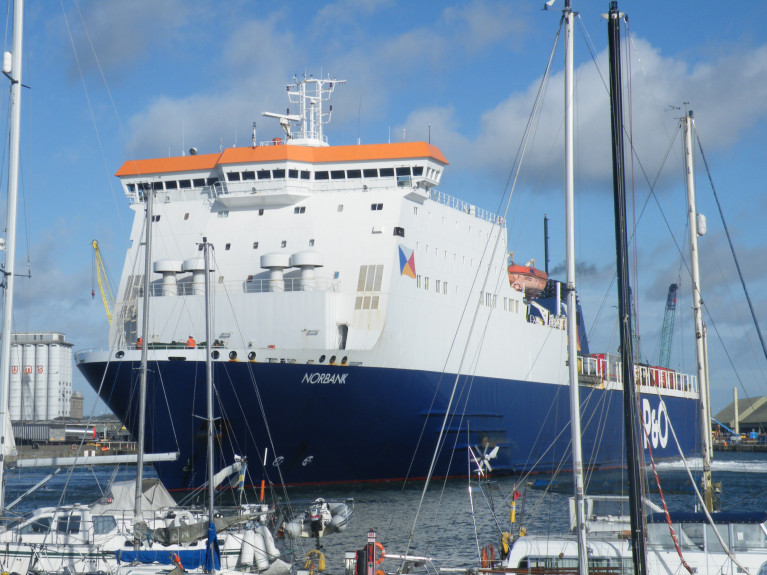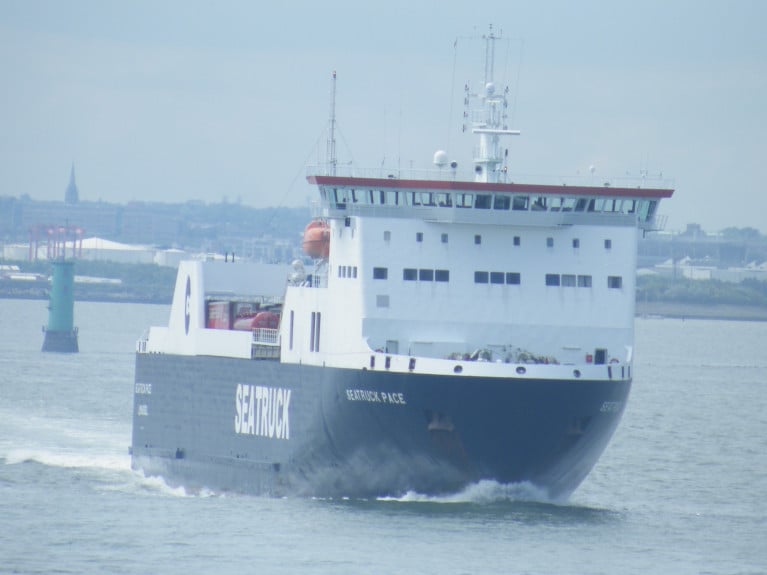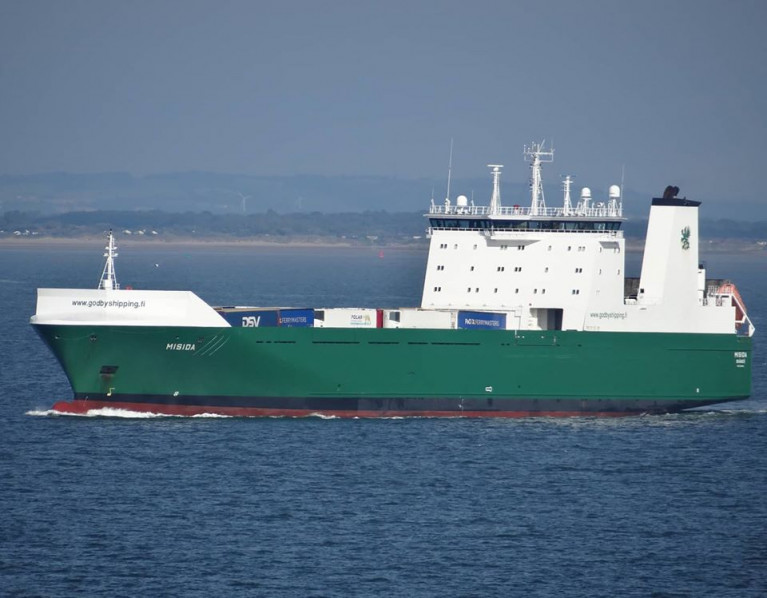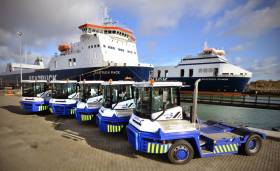Displaying items by tag: DublinLiverpool
Stena Line to Boost Capacity on Dublin-Liverpool (Birkenhead) Route with Dedicated Freight-Only Vessel
Stena Line has secured a freight only ro-ro vessel, Bore Song, to operate on its Dublin-Liverpool (Birkenhead) route with the ship boosting freight capacity on the Irish Sea route by 30%.
The Swedish operator of the Dublin-Liverpool dedicated freight service has been operational since 15th February with the ropax Stena Horizon serving customers temporarily, whilst the company searched for a longer-term solution.
Bore Song is now scheduled to undergo modifications and is expected to enter service in mid-April.
With capacity for almost 3,000 lane metres of freight, the Bore Song will provide significantly more space and is well suited for this unaccompanied freight route. Once the ship is operational, Stena line will be able to restore normal capacity and operations on its Rosslare-Fishguard and Rosslare- Cherbourg routes.
With the future of the route front of mind, the company is also investing further in its port operations at Birkenhead to better serve freight customers. Stena Line recently broke ground on a project to significantly increase parking for freight vehicles with plans for 200 additional
bays.
This follows the announcement last year that the ferry operator had signed an agreement with Peel Ports to operate at the terminal in Birkenhead until the year 2100.
Paul Grant, Trade Director Irish Sea, Stena Line said, “Since we announced our plans to launch our Dublin-Liverpool service in December, we have been searching for a long-term freight only ship solution, and we’re delighted to have secured the Bore Song to serve on the route until at least the end of the year.
“The extra capacity offered by Bore Song will be welcomed by the market. The service has had a strong start and we anticipate further growth in the coming months. Coupled with the expansion of our port operations in Birkenhead and our long-term agreement with Peel
Ports, we’re investing significantly in the future of our seventh service across the Irish Sea.”
Stena Line is the largest ferry operator on the Irish Sea, with the biggest fleet providing up to 248 weekly sailings on routes including combined passenger and freight services from Belfast to Cairnryan; Belfast to Liverpool; Dublin to Holyhead; Rosslare to Fishguard and Rosslare to Cherbourg.
The company also runs a dedicated freight only route from Belfast to Heysham, in addition to the new Dublin – Liverpool service.
An Irish Sea ferry was among those at UK shipyards on England's North Sea coast, where A&P North East's Tyne and Tees faclities reported a strong two-month period.
Afloat adds the ferry, ro pax Norbank, which P&O Ferries operates on the Dublin-Liverpool link, had called for annual docking, while twin Norbay and chartered in freight-only vessel, Stena Forcaster continued sailings.
Also in April, the same ferry owner's, Pride of Kent, a passenger ferry docked for steel repairs as part of its annual maintenance programme.
Asides A&P North East carrying out work on ferries, other ships in the form of tankers, dredgers and OSVs called on the business’s engineering and ship repair expertise.
According to the shipyard team, currently at the facility is Prysmian’s cable laying barge, Ulisse, after a successful dry docking period for a special survey. In addition docked on the Tyne, the diving support vessel Boka Polaris for a change of owners’ livery.
Scottish-based Northlink Ferries (see CMAL acquired) has also selected A&P North East to carry out a number of small repairs to ro-ro MV Helier when the freighter visits later this month.
A number of mobilisations have also been delivered including the Normand Samson in the Port of Tyne as well as the Olympic Triton and Zwerver I in Teesside.
The Tyne-based team is also preparing to begin mobilisation work for Prysmian’s Da Vinci, described as the most capable cable layer with the highest carousel capability on the market.
Over at A&P Tees, the last few months have seen the team deliver annual dockings for the City of Westminster, Arco Dijk and Sand Falcon dredgers as well as a growing number of offshore vessels thanks to the facility’s proximity to the North Sea. The most recent project was for North Star Shipping’s Grampian Sovereign.
Other projects have included a Condition Assessment Programme (CAP) survey for the tanker vessel Mersey Fisher, routine maintenance work for Briggs Marine’s Forth Atlas barge and Forth Warrior tug, and a return maintenance visit from PD Teesport’s Cleveland County.
Speaking about the recent successes at both North East facilities Chris Davies, Business Development Manager for Marine at A&P Group said: “The market is very buoyant right now and the location of our two North East facilities makes us well placed to capitalise on the available work. We are pleased to secure more work in the offshore sector at A&P Tees in particular, and to leverage the growing expertise and resource we have in this area.
“The successes of the last few months reflect the hard work and dedication of our team throughout the pandemic and our long-standing relationships with clients and their returning vessels.”
Ro-ro freight operator Seatruck Ferries announced today an increase in capacity with an extra two roundtrips on the Irish Sea central corridor Dublin Port-Liverpool route this week.
The new sailings arise from an increased demand which will see the first additional roundtrip sailing depart Liverpool (this afternoon) at 16:00 and returning from the Irish capital tomorrow (Wednesday) morning at 04:00.
Customers will now have the option of 4 departure times from Liverpool on Tuesday and Wednesday and 4 departure times from Dublin on Wednesday and Thursday.
To consult 'weekly' updated sailing schedules click here.
It is only just over a month ago when Seatruck announced the resumption of passenger (motorist-only) sailings following lifting of Covid-19 travel restrictions. Customers have the entire operator's Irish Sea route network to choice from of the following routes: Dublin-Liverpool, Dublin-Heysham and Warrenpoint-Liverpool.
Combined there are 7 ships on these routes served by the 'P' series and larger 'Heyham-Max'/FSG ro-ro freighters. The fleet has a freight capacity ranging from 100-135 un-accompanied trailers and 12 passengers can be accommodated on each ship.
Finnish Island Based Operator's Ro-Ro Freight-Ferry Feeds into P&O's Dublin-Liverpool Service
A Finnish island based shipping operator has a ro-ro freighter on charter to P&O Ferries Dublin-Liverpool on the intensive central Irish Sea corridor link which currently only has one passenger ferry in service, writes Jehan Ashmore
Godby Shipping AB of Mariehamn, the capital of Åland Islands located in Baltic Sea between Finland and Sweden, has its ro-ro freight only Misida time-chartered to P&O. Misida brings a boost in capacity for 150 trailers (2,155 freight lane meters) throughout the decks of the 2007 built 14,100 gross tonnage ship.
Misida last month became the fourth ship to boost capacity having joined P&O's ropax sister's Norbank and Norbay in addition to another charter of Clipper Pennant from Seatruck Ferries. However, currently the service is reduced to three ships as Afloat reported the 125 freight-trailer / 114 passenger ropax Norbay is offservice from the Liffey-Merseyside link due to dry-docking on the opposite side of the England at the facility of A&P Tyne, near Newcastle on the North Sea.
In the meantime Misida operates Norbay's roster with the 22.50 arrivals (Mon-Fri) to Dublin Port and departures at 03.00 (Tue-Sat) for Liverpool on the 8 hour passage. This leaves only Norbank as the sole passenger carrying ship linking Ireland and Britain, though it should be note 'no' foot passengers are conveyed.
Misida however will only remain on the Irish Sea charter with P&O until this month as the ship along with sister Misana in October, have been chartered to Norwegian liner operator Sea-Cargo. The pair are Godby's largest ships out of seven-ship fleet are to be deployed between the Nordic nation and continental Europe.
So will P&O seek another replacement freighter when Misida is expected to leave the service this month?
The presence of Misida in the meantime on the Irish Sea recalls a fleetmate Mistal from last year's charter to P&O, though this freighter initially provided relief duties before taking over the roster of European Endeavour which was later sold to Scandinavian interests.
In disposing the largest ship on the Liverpool link last year, P&O Ferries passenger capacity was also reduced as European Endeavour carried 300 compared to 114 each of Norbank and Norbay. The pair were transferred from North Sea service in 2002 to the Irish Sea between Dublin and Gladstone Dock, Liverpool.
By coincidence the European Endeavour was sold to another Finnish operator, Ederi AB Eckerö and renamed Finbo Cargo. Despite as the name suggest, the ship also takes passengers on a Finland-Estonia no-frills route branded as 'Finbo Cargo by Eckerö Line' on the link connecting Helsinki (Vuosaari) to Tallinn (Muuga) where these outlying ports are located to the east of both Baltic capitals.
Eckerö Line also operate MS Finlandia (originally Moby Freedom from Italy) which offers a faster 'cruiseferry' based service directly connecting the ports of Helsinki and Tallinn.
Also currently operating in the Baltic is Mistral as Afloat tracked this morning (repositioning voyage?) between Kotka, Finland and Hirtshals, Denmark. The deployment of the freighter is understood to have only begun this month, though the charterer requested not to be known as outlined last month on Godby's website.
Previously, Mistral from the beginning of this year was chartered to Spanish ferry operator, Balearia on a mainland-Canary Islands service linking Huelva-Tenerife-Las Palmas.
Containers: BG Freight Line Introduce Tri-Weekly Dublin-Liverpool Service to Meet Growing Demand
Container operator BG Freight Line has taken a positive step by adding an additional weekly service call to meet the growing demands of traffic between Liverpool and the Irish Sea hub.
The newly announced service will call between Liverpool and Dublin Port on a tri-weekly basis, ensuring a regular facility to the meet the dynamic needs of each customer in the fast-paced environment of short-sea shipping.
BG Freight Line, part of the Peel Ports Group, provides a comprehensive range of logistics services to and from Ireland, the UK and continental Europe. These services include door-to-door shipping, feedering and quay-to-quay shipping for all types of containerised cargo.
Koert Luitwieler, CEO, BG Freight Line, said: “Our sailing schedule is amongst the best in the business and as part of the Peel Ports Group, we are able to offer the assurance to our customers that we are both an established and reliable partner.
“We are always looking for new growth opportunities and adding another service to the Dublin – Liverpool route will strengthen our excellent Irish Sea network even further. The extra call in Liverpool allows us to meet the demands of our customer, giving them greater flexibility to move last minute cargo closer to its end destination in an ever-changing landscape”.
David Huck, Managing Director, Peel Ports said: “We are delighted to welcome this extra weekly service as it reinforces the strategic importance of this route, as well as our ambition and commitment to provide the seamless movement of goods between Dublin and Liverpool.
“During these uncertain times, it’s imperative that we remain agile for our customers and remain customer-focussed to find a fast solution that ensures cargo, especially essential supplies reaches its destination on time”.
The Port of Liverpool is ideally positioned to be at the heart of a distribution network for UK and Irish markets. The Port is adept at offering innovative and sustainable solutions for warehousing, manufacturing and retail industries, connecting the UK’s major conurbations to both the Irish Sea Hub and beyond.
Seatruck's Sailings Increase On Dublin-Liverpool Route
Freight ferry cargo levels continue to improve with Seatruck as a result the Irish Sea operator has announced the re-introduction of the 15:30 sailing ex Dublin Port on Thursday's and the 03:30 sailing ex Liverpool on Friday's.
This additional round-trip came in practise last Thursday with the ex Dublin sailing.
Seatruck have already reinstated Tuesday morning sailings onto the Warrenpoint – Heysham route. The operator say they continue to monitor cargo levels and evaluate customer feedback to determine the number of sailings required on each route.
The 'P' class vessels (currently operating on the Dublin-Heysham and Dublin-Liverpool routes) can accommodate 12 passengers in single cabins.
As for the 'FSG' class (currently operating on the Dublin-Liverpool and Warrenpoint-Heysham routes) continue to operate with a maximum of 6 passengers per vessel, allowing drivers to have a single cabin for the duration of the voyage.
For further information contact the relevant port for booking information.
In regards to the latest schedule information, follow the link HERE to the 7-day live schedule or download the Seatruck schedule App.
In March due to Covid-19 there was a temporary stop in carrying HGV drivers and passengers on board.
Currently in Dublin Port is Seatruck Power (as pictured above).
In addition Afloat also tracked Seatruck Panorama having left Dublin Bay and ahead further into the Irish Sea is a another 'P' class, Clipper Pennant.
Both these ro-ro freight-ferries this afternoon are bound for Merseyside.
Seatruck Further Increase Capacity on Dublin-Liverpool Service
#FerryNews - Irish sea freight operator, Seatruck Ferries have further increased capacity on their Dublin to Liverpool service. In addition sailing frequencies on the central Irish Sea corridor route.
The smallest vessel on the route the Clipper Ranger, has been replaced by a larger P series vessel, (Afloat identified as Clipper Pennant) offering almost twice the capacity. At the same time additional Friday sailings have been introduced meaning that Seatruck now operate 44 sailings per week on what is their busiest Irish Sea service.
The introduction of the larger Clipper Pennant is the next stage in Seatruck Ferries’ strategic development plan, with the company now operating 78 departures per week across 3 key routes on the Irish Sea.
Responding to customer feedback, departure times have also been tailored to reflect the changing needs of the Irish market. Seatruck currently move around 20% of the total Irish Sea roro freight volumes.
Driver shortages are causing many operators to reassess their traditional accompanied method. Seatruck Ferries believes in a switch to greater volumes of unaccompanied movements from ports, which reduces road mileage compared with the more traditional transit through Wales or Scotland. Trailer only shipments mean that Seatruck customers can use their drivers and equipment more efficiently.
This positive move will complement the existing Seatruck services operating from Dublin to Heysham and Warrenpoint to Heysham.
As Afloat previously covered, capacity on the Warrenpoint-Heyham route has just been increased by 30% with introduction of sisters Seatruck Performance and Seatruck Precision.
Alistair Eagles, Chief Executive of Seatruck Ferries said: “The recent vessel changes in Warrenpoint have allowed us to cascade additional modern tonnage onto our fast-growing Dublin – Liverpool route. The P series vessel is larger, faster and will improve schedule reliability in inclement weather.
He add "We are seeing unprecedented demand for unaccompanied trailer shipments across our network and with the driver shortage worsening we see this trend continuing. By switching to unaccompanied shipments our customers can ensure that they are using their resources in the most efficient way possible. The Dublin Liverpool route is now serviced by a modern fleet of purpose-built vessels offering unrivalled service for trailer operators with 4 midweek sailings per day in each direction.”
The vessel switch follows exponential growth for Seatruck in recent years with trailer volumes rising by more than 250% since 2007.
Increased Seatruck Sailings Launched on Dublin-Liverpool Service
#freightferry - Irish Sea freight-only ro-ro operator, Seatruck Ferries has from today increased capacity by adding Tuesday morning sailings on the core Dublin-Liverpool route, writes Jehan Ashmore.
Due to increased demand, Seatruck Ferries new Tuesday morning sailings on the busy central corridor route, will take the service total to 40 sailings per week.
The particular vessel operating this morning's sailing from Dublin Port is the Seatruck Power. The ro-ro freighter which was completed by FSG, Germany in 2012 has a capacity for 150 freight units spread across 2,166 lane metres.
In total, the operator now offers Irish Sea customers 74 sailings per week, allowing for greater flexibility in the shipment of unaccompanied trailers.
The company also operate Dublin-Heysham and Warrenpoint-Heysham. Among the 10-strong fleet is the 65 unit freight ferry Arrow that is on charter to the Isle of Man Steam Packet Co.
The ship which acts as a relief vessel is currently away from Manx waters due to the dry-docking of a freighter from Condor Ferries, the main operator serving the Channel Islands.
#Charter -A Maltese flagged Greek owned vehicle-carrier only vessel is on charter to an Irish Sea ferry operator while its ships take refit dry-docking turns in the UK, writes Jehan Ashmore.
The chartered-in Neptune Aegli can handle 1,800 cars or 1,550 lane metres of truck/trailers has begun a first sailing today for P&O Ferries. This involved an afternoon crossing from Dublin to Liverpool.
Neptune Lines operates a fleet of 16 Pure Car & Truck Vehicle Carriers (PCTC) from which Neptune Aegli joins P&O’s European Endeavour and ropax Norbay. Noting sister, Norbank this morning entered a dry dock at Cammell Laird, Birkenhead. The shipyard and marine engineering facility located on the Wirral Peninsula is opposite to Liverpool Docks.
It is a year ago when Afloat reported on the charter to P&O of Neptune Aegli. On this current charter, the 2002 built PCTC had docked in Dublin yesterday having assisted P&O operations on the North Sea. This saw the ship provide freight support relief duties for Hull-Zeebrugge ferries sisters, Pride of York and Pride of Bruges that underwent multi-million career-extension refits.
The annual refits of the North Sea 32,000 tonnes sisters took place in Gdansk, Poland, where work on the near 900 passenger each cruiseferry involved overhauls of shops, catering experience outlets and cabins and bars will now have hotspot wi-fi. In addition the extensive upgrade was carried out throughout facilities for freight customers on the UK-Belgium route.
Pride of York when launched from Govan Shipbuilders on the Clyde as Norsea in 1986 was the largest ever passenger ship built in the UK since Cunard Line’s Queen Elizabeth dating to 1969.
The famous trans-Atlantic ocean liner had too been built on the banks of the Clyde but from the John Brown yard.
Third Seatruck Ferry ‘Revealed’ for Liverpool Service
#ThirdFreightFerry - Seatruck Ferries have confirmed to Afloat.ie as to the identity of the third vessel to be introduced on the Dublin – Liverpool route. She is the Clipper Ranger which is scheduled to take up service early next week, writes Jehan Ashmore.
The introduction of this third freight-ferry as previously reported is to bring additional midweek departures on much needed peak capacity sailings. The Ireland-England route according to Seatruck is attracting increasing support from unaccompanied traffic.
Clipper Ranger is a 'R' class freight-ferry with capacity for 65 units and 1,057 lane metres. She is to operate six sailings mid-week (three in each direction).
The move to add Clipper Ranger is in direct response to the demand and feedback from freight customers changing needs of the Irish market. Driver shortages are causing operators to reassess their traditional accompanied method.
She will join the route’s FSG ‘Heysham-max’ class sisters Seatruck Progress and Seatruck Power, each with 150 units and 2,166 lane metres. Together the trio of freight ferries will operate 30 departures each week.
For more including news on the Dublin-Heysham route, click to the previous report.



































































